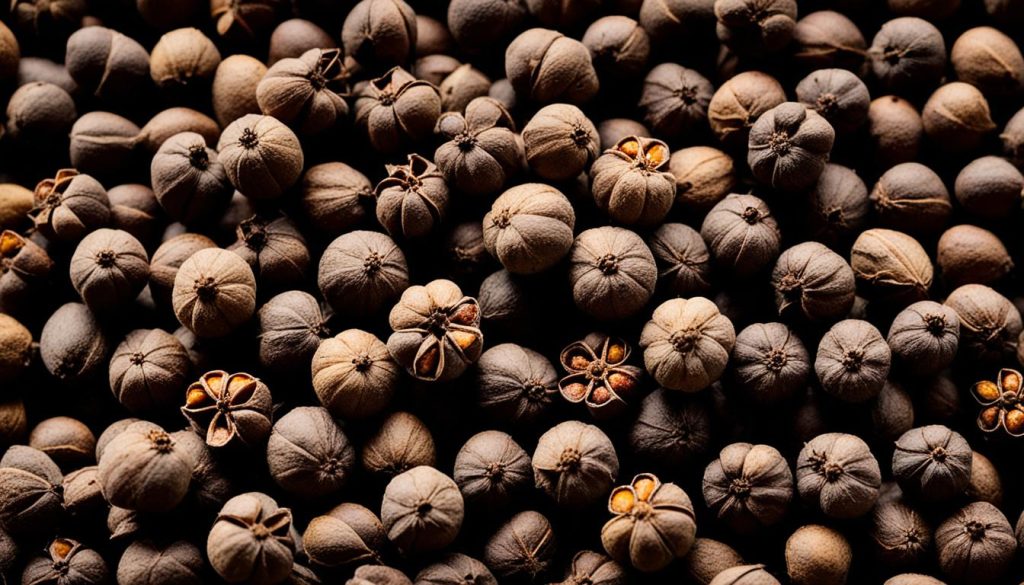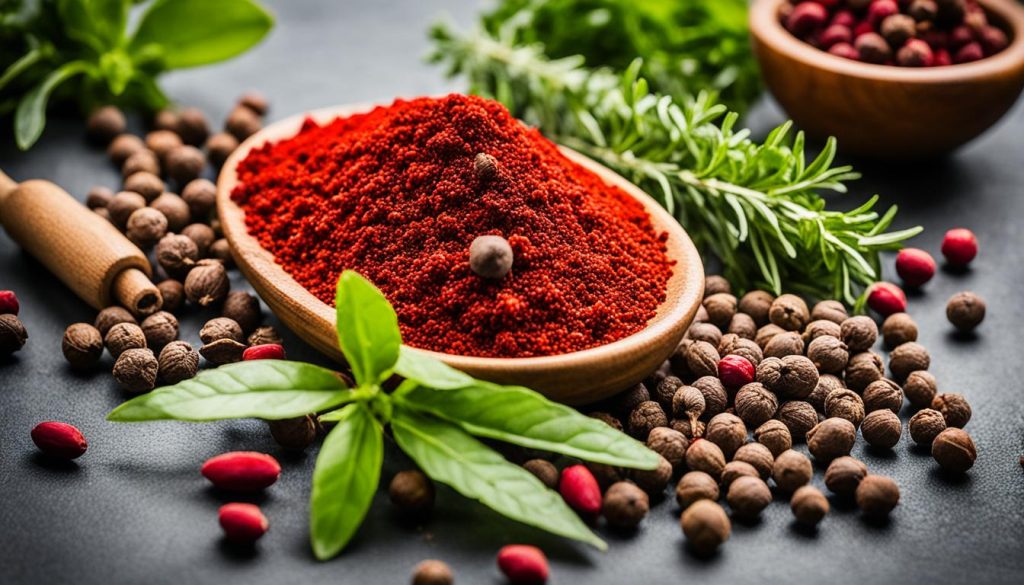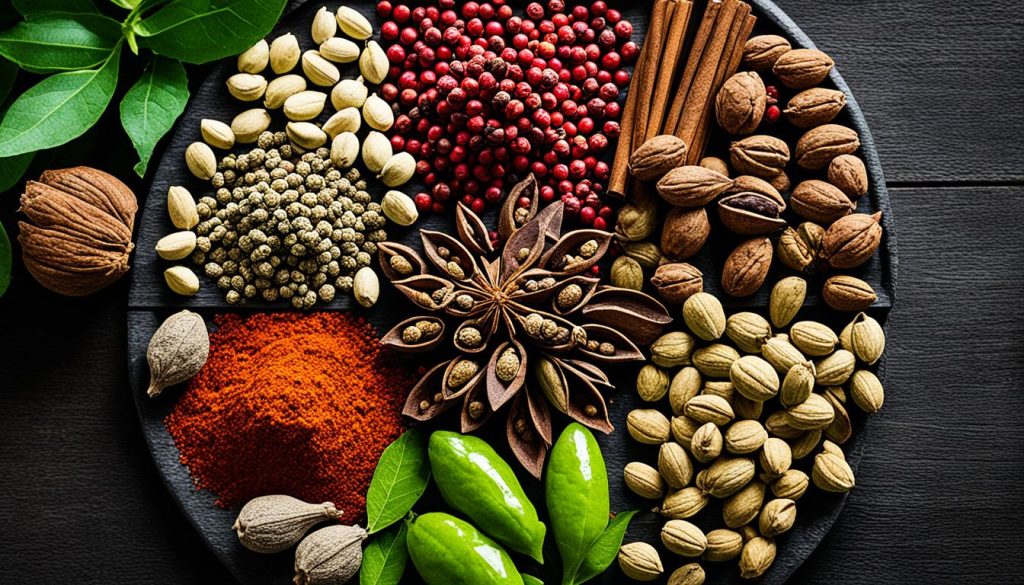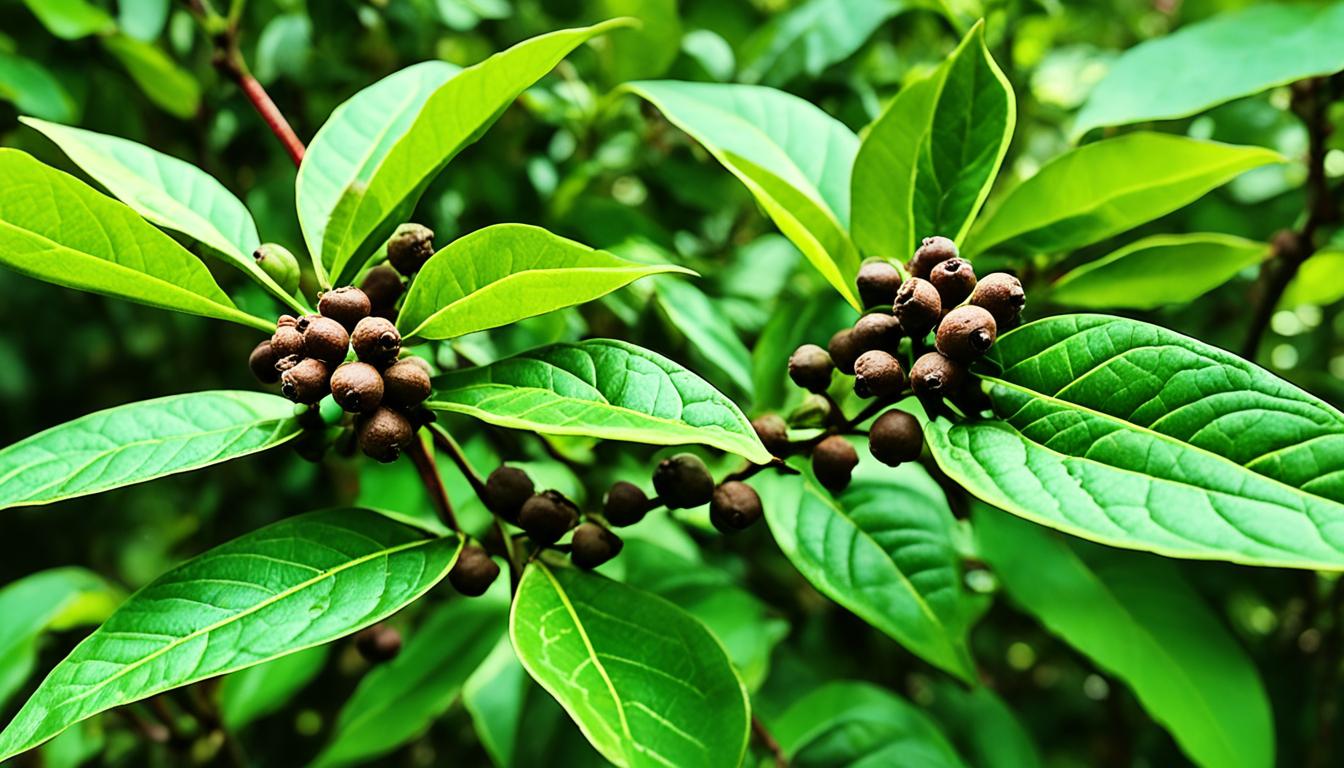I love exploring the unique flavors of the Caribbean. Allspice, also known as Jamaica pepper, caught my eye. It’s from the West Indies, Southern Mexico, and Central America. This spice blends warm cloves, sweet cinnamon, and nutty nutmeg flavors.
Allspice makes both sweet and savory dishes taste better. It’s a key spice in many global cuisines. This makes it the Caribbean’s secret ingredient for bold flavors.
Allspice is also good for your health. It has antimicrobial and antifungal properties. It might help with menopause relief and cancer-fighting.
We’ll look into allspice’s unique taste, its uses in cooking, and health benefits. If you love cooking or are just curious, you’ll learn to appreciate this versatile Caribbean spice sensation.
The Enigmatic Allspice: A Multidimensional Flavor Sensation
Allspice has a story that goes far beyond its familiar smell. It’s not a mix of spices but one spice from the Pimenta dioica tree’s unripe berries. These berries turn into the brown allspice we love after being picked, fermented, and dried.
From Berry to Spice: The Journey of Allspice
Allspice tastes like a mix of cloves, nutmeg, cinnamon, and black pepper. This makes it a versatile and complex spice. It’s known as the “sophisticated cousin” of pumpkin spice, with a unique taste.
A Flavor Profile Like No Other: Pumpkin Spice’s Sophisticated Cousin
Allspice is different from pumpkin spice with its deep and complex taste. It comes from the Caribbean and is loved worldwide for its unique flavor. Exploring the journey of allspice or its flavor profile will show you its magic.

“Allspice is a truly unique and fascinating spice, with a flavor profile that sets it apart from any other. Its complexity and versatility make it a true culinary gem.”
Versatility in the Kitchen: Allspice’s Global Culinary Journey
Allspice is a spice that goes well in many kitchens around the world. It brings a special flavor to both sweet and savory dishes. From the Caribbean to the Nordic regions, it adds depth and complexity.
From Jamaican Jerk to Swedish Pickled Herring: Allspice’s Cultural Diversity
In the Caribbean, allspice is a key part of Jamaican jerk seasoning. It gives grilled meats a warm, complex taste. In the Middle East, it’s used in kibbeh and kafta.
In Europe, it’s found in baking and pickling, like in Swedish pickled herring. North American cuisines also use it, in pumpkin pie spice and barbecue sauces.
Allspice can fit into many cooking traditions because of its unique flavor. It adds depth to savory dishes and sweet treats alike. This spice is a global culinary star.

| Cuisine | Allspice Usage |
|---|---|
| Jamaican | Key ingredient in jerk seasoning |
| Middle Eastern | Used in dishes like kibbeh and kafta |
| European | Found in baking and pickling, such as Swedish pickled herring |
| North American | Common in pumpkin pie spice and barbecue sauces |
Allspice fits well into many cooking traditions because of its unique flavor. It adds depth to savory dishes and sweet treats. This spice is a global culinary star.
Allspice: The Caribbean’s Secret Ingredient for Bold Flavors
In the Caribbean, allspice is a secret ingredient. It adds depth and a unique flavor to many dishes. It’s used in Jamaican jerk seasoning and even in pickled herring.
Allspice makes both sweet and savory dishes better. Its warm, slightly sweet taste can turn simple dishes into something special. Chefs and home cooks use it to add Caribbean flavor to meats, stews, and baked goods.
“Allspice is the unsung hero of Caribbean cuisine. It’s the ingredient that adds that je ne sais quoi to our favorite dishes, elevating them to new heights of flavor.”
Allspice is not just for Caribbean cooking. It’s used in many cuisines around the world. You can find it in Scandinavian pickled herring and European mulled wines.
If you love Caribbean cooking or want to try new flavors, allspice is key. It brings bold, complex flavors to your dishes. Let it take you on a culinary journey through the Caribbean.

Health Benefits of Allspice: Nature’s Multitasker
Allspice is more than just a spice for cooking. It’s a natural remedy with many health benefits. This spice from the Caribbean has been studied a lot. It shows many ways it can help our health.
Menopause Relief: Allspice’s Estrogenic Potential
Allspice might help ease menopause symptoms. It has compounds that act like estrogen. This could help balance hormones during menopause.
Women in menopause might find relief from hot flashes and mood changes by eating allspice.
Cancer-Fighting Properties: Allspice’s Arsenal of Plant Compounds
Allspice is good for more than just menopause. It’s full of compounds that fight inflammation and might even help against cancer. These compounds can protect us from harm caused by stress and inflammation.
“Allspice is not only a culinary delight but also a natural remedy with a host of potential health benefits.”

Allspice is useful beyond cooking. It can be a key part of a healthy lifestyle. It offers benefits like easing menopause symptoms, fighting inflammation, and possibly preventing cancer. Plus, it tastes great.
Antimicrobial and Antifungal Allspice: A Natural Remedy
Allspice is a spice from the Caribbean that is full of natural power. It has compounds like eugenol and ericifolin that fight off many harmful germs. These compounds are studied a lot for their strong effects.
Research shows that allspice essential oils can kill off Candida albicans yeast. This yeast is hard to kill with some medicines. The oils also fight bacteria like E. coli and Salmonella. They do this by damaging the bacteria’s outer layer.
Allspice is great for fighting germs and fungus naturally. It’s used in cooking and could be used in medicine too. Chefs and scientists love this spice for its many uses.
| Microbial Organism | Antimicrobial Activity of Allspice |
|---|---|
| Candida albicans | Strong antifungal activity |
| E. coli | Antibacterial effects |
| Listeria monocytogenes | Antibacterial effects |
| Staphylococcus aureus | Antibacterial effects |
| Salmonella | Antibacterial effects |
Allspice is great for fighting germs and fungus naturally. It’s used in cooking and could be used in medicine too. Its ability to stop harmful germs makes it a valuable spice.
How to Use Allspice in Cooking
Allspice is a spice that makes both sweet and savory dishes special. It has a warm, complex flavor. It’s a must-have in every kitchen, for both home cooks and chefs.
Allspice: A Versatile Spice for Sweet and Savory Dishes
Whole allspice berries add flavor to broths, ciders, and wines. They’re like whole cloves but with a unique smell. For sweets, ground allspice goes into pumpkin pies, caramel sauces, and ice cream. It makes these treats richer and more flavorful.
In savory dishes, allspice is key in Jamaican jerk seasoning, Middle Eastern baharat, and Mexican mole. It boosts bold flavors. This makes it a top choice for any spice collection. It lets you try new things with uses of allspice in cooking and allspice in sweet and savory dishes.
| Dish | Use of Allspice |
|---|---|
| Jamaican Jerk Chicken | Allspice is a core ingredient in the spice blend, adding warmth and complexity to the dish. |
| Pumpkin Pie | Ground allspice is a common addition, complementing the pumpkin’s natural sweetness. |
| Mulled Wine | Whole allspice berries infuse the wine with their aromatic, spicy-sweet notes. |
Allspice is a must-have spice that can make any dish better. It’s perfect for both sweet and savory dishes. Try it out and see how it can make your cooking amazing.
Allspice: The Spice Rack Essential for Bold Caribbean Flavors
I love exploring the rich flavors of Caribbean cuisine. Allspice is a key spice in many dishes. It adds a unique taste that makes Caribbean food special.
Allspice is a must-have in Caribbean cooking. It adds a smoky, spicy taste to dishes. Whether used whole or ground, it changes the flavor of both sweet and savory foods.
Using allspice brings Caribbean flavors to life in my cooking. It goes well with many foods, from fruits to meats. This spice helps me make dishes that taste like they’re from the Caribbean.
“Allspice is the secret weapon in my culinary arsenal when it comes to creating bold, authentic Caribbean flavors.”
If you like Caribbean food or want to try new flavors, keep allspice handy. It’s great for making dishes taste like they’re from the Caribbean. It’s a key spice for anyone wanting to add Caribbean flavor to their cooking.
Allspice: Tracing Its Origins and Cultural Significance
Allspice comes from the West Indies and Central America. The Pimenta dioica tree, its source, grows there. Christopher Columbus found it on his second trip to the New World.
The Caribbean’s native people used the berries for flavor and medicine. Over time, allspice spread to many cultures. It became important in the Middle East, Europe, and North America.
This spice tastes like cinnamon, cloves, and nutmeg mixed together. Its unique taste has made it a key spice in many dishes. You can find it in Jamaican jerk seasoning and Swedish pickled herring.
“Allspice is the secret ingredient that adds depth and complexity to so many beloved dishes. Its versatility and distinctive flavor make it a true star in the spice world.”
The origins of allspice and its cultural significance are tied to Caribbean history and food. This spice still excites the senses and inspires cooks everywhere.
The Allspice Tree: A Botanical Marvel of the Tropics
I’m diving into the world of allspice and finding the allspice tree amazing. It’s an evergreen tree that grows in the tropics. Known as Pimenta dioica, it’s part of the Myrtaceae family and comes from the West Indies and Central America. It can grow up to 40 feet tall, with small white flowers that turn into allspice berries.
The allspice tree is tough and can live in hot, humid places with good soil. It shows how well it can grow in lush areas. When the berries get ripe, they turn from green to a deep brown. Each berry has two seeds that make the allspice spice we all enjoy.
This tree is truly a wonder of nature, showing off the beauty of the tropics. Its journey from delicate flowers to tasty berries is amazing. It’s a sign of how well it has adapted to its home. As I learn more about allspice, I’m amazed by this tree’s strength and its importance in the Caribbean and Central America.

